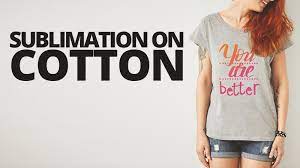Sublimation on cotton is a process in which dye is transferred to a cotton material by heating it. This process is similar to regular sublimation, but there are some differences between the two methods. The process begins with transfer papers, which are printable and are applied to cotton shirts with a heat press. The dye from the transfer paper then transfers onto the cotton shirt’s surface. Once the transfer process is complete, the transfer paper is discarded.
Process of dye sublimation
Sublimation printing works by impregnating the material with color. It is compatible with cotton and other non-coated fabrics. The process is based on the fact that the dye particles change from a solid state to a gaseous one. The polymer in the dye then bonds with the dye, imparting color to the fabric.
To make this process work, you will need to prepare the cotton and the dye. This means obtaining special synthetic spray coatings or HTV cutouts for the sublimation transfer. If you don’t want to spend the money on special equipment, a popular method is to apply white glitter heat transfer vinyl to cotton. You can then apply the sublimation dye on top of the glitter vinyl.
Materials required
If you’re ready to try sublimation on cotton, you need to have the right materials in hand. You’ll need polyacrylic dye, cotton, and water. You can purchase polyacrylic at most home improvement stores and craft stores. You don’t want to shake the container when scooping out the dye; you want to gently stir the powder in a cup or dish. After stirring, pour the mixture into a spray bottle.
The next step is to mix the colors. Colors should coordinate. You’ll also need a plastic bag for mixing the colors. Then, you’ll use a paintbrush to apply the mixed sublimation ink to the paper.
Problems with sublimation on cotton
There are several problems that can arise when you use sublimation on cotton. For starters, it is important to choose the right digital transfer paper. Different digital transfer papers have different characteristics and will affect the color and image quality. They also absorb dye differently. You must choose a digital transfer paper that has the right properties.
In addition, sublimation on cotton can lead to washing problems, since the dyes used in the process are not chemically bonded. Moreover, since the fabric is made of cotton, it will eventually peel and crack as the product ages.
Solutions
When it comes to sublimation on cotton, it is important to make sure that the dyes are compatible with the fabric. Unlike other substrates, cotton does not bond with sublimation inks. This means that your product will have an irregular surface with images that may peel, crack, and fade over time. This is the same problem that plagues traditional forms of cotton decorating. To prevent these problems, it is important to make sure that you use a good sublimation paper for cotton.
There are many different transfer papers for sublimation on cotton. Each has different characteristics that affect the image quality and color. Moreover, the paper must be able to absorb and release the dye properly. As a result, not all digital transfer papers are created equal.

